 Mini Review
Mini Review
Developing a Protocol “Cattle Barn Fire”
Noordhuizen Jos P*
Formerly at Utrecht University and Wageningen Agriculture University (NL), Gent University (B), National Veterinary School in Nantes and Lyon (F), Charles Sturt University (Au)
Corresponding AuthorNoordhuizen Jos P, formerly at Utrecht University and Wageningen Agriculture University (NL), Gent University (B), National Veterinary School in Nantes and Lyon (F), Charles Sturt University (Au).
Received Date:June 07, 2022; Published Date:June 12, 2022
Abstract
Fires on farms with animals still occur annually. The causes of such fires can be many in nature, although a farm’s electrical system may play a specific role in fire causes. Farm fires result in major economic losses and dramatically compromised welfare. If the animals survive at all, there is little chance of recovery, while productivity is significantly affected. These animals will often have to be disposed of early.
Fire prevention through protocols is a key word in modern farm management. One can compare such protocols with the biosecurity plans that deal with animal health. In addition to prevention, attention should be paid to the actions that a farmer and his/her staff can already take themselves to contain an incipient fire until the Fire Department arrives.
This article focuses on causes of fire in farm buildings with cattle, the main risk factors involved, the development of a prevention “protocol farm fire” as well as the development of a “fire action plan”. The veterinary farm advisor can play a supporting role in the development of such protocols, as he/she does already in biosecurity plans.
Introduction
Fires in commercial buildings, including farm homes, occur frequently each year. Smoke alarms are mandatory in homes and small hand-held fire extinguishers are sometimes present. The causes of fires in buildings have changed little over the years. Table 1 lists the main causes [1].
Table 1:Overview of major causes of fire in buildings and homes [1].

Table 2:An example of fire causes on farms, related to electrical installation, one of the most common causes [2] Brochure du Gouvernement Québec, Ministère de la Sécurité Publique.
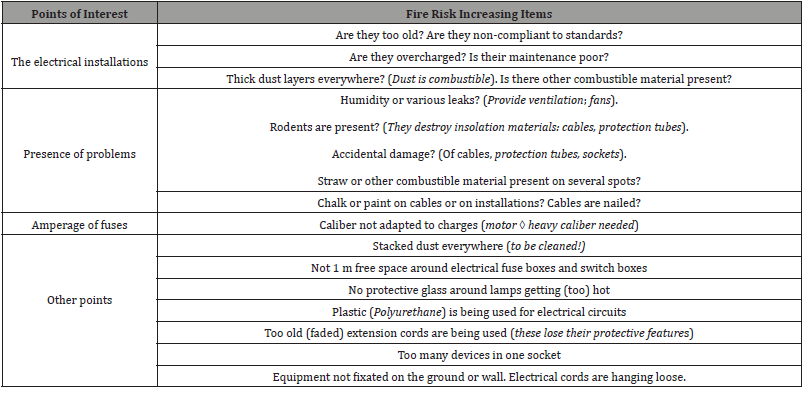
The main causes of fire related to electricity are then shown in Table 2 [2]. The electrical system is a leading cause of fire in farm animal buildings.
The results of Table 2 indicate several human factors involved in the occurrence of fire in cattle barns. Important risk factors are maintenance of electrical installations, overloading of installations, too weak amperage of fuses, layers of dust, damage to pipes, leaks. The risk factor of straw or litter (wood chips) is present too.
This article focuses on fire in cattle barns, from a general point of view.
The purpose of this article is to arrive at a general “protocol for fire in cattle barns,” which lists important actions that can be both preventive and curative in nature. The specific implementation is farm-dependent, must be tailor-made and therefore cannot be detailed here.
Fire In Cattle Barns
Farm fire is a sometimes-unavoidable catastrophe, leading to great suffering for the people involved, but certainly also for the animals housed. Mortality of cattle is a common phenomenon, especially in outbreak fires. Even if the cows survive, they may show severe symptoms that in many cases lead to disposal. The most affected organ is the respiratory organ, because of the heat of the fire itself, but especially from the smoke production [3]. Smoke itself is also combustible and toxic, depending on the substances contained in the smoke. Examples of such substances are gases (CO, CO2, HCN, NO), chemicals (formaldehyde, H2S, hydrocarbon, dioxin, acrolein, benzene), soot particles and fine particulate matter. Especially the latter can, if they are less than 10 microns in size, penetrate deep into the lungs and lead to destruction of cells. By comparison, human hair has a size of 60 microns [3].
The objectives of a Fire Department in case of fire are to rescue people; to guide evacuation of people from a building; to create survival conditions; to secure entry into a building; to limit fire spread; to extinguish the fire; to limit environmental and social impacts [4]. Choices need to be made.
Fires on farms with cattle lead to major economic damage and hugely compromised animal welfare. It is therefore important to take a preventive approach and draw up a Protocol Barn Fire (PBF), incorporating the most important preventive measures. In addition, it is strongly indicated to also draw up an Action Plan Fire (APF), with specific instructions what to do, when how and where and by whom, in case of a fire. This can benefit the activities of the Fire Department and thus the outcome. In everything, the safety of the people must be paramount.
The Broad Outlines of a Protocol Cattle Barn Fires (PCBF)
A protocol serves to be properly prepared for an emergency such as a fire. To this end, it contains actions and instructions that can be vital to the people and instructions that can save as many animals and the farm as possible.
It is strongly recommended to develop the “protocol cattle barn fires” (PCBF) together with the Fire Department. To do this, however, it is necessary for the cattle owner to first map out the basic outlines of such a PCBF him/herself.
Table 3 contains as an example a preliminary elaboration of a PCBF, with domains for action and specific instructions. Some actions/instructions are meant to be preventive, and other measures and actions applicable in case of fire outbreak itself (Action Plan Fire, APF) as presented in Table 4.
Table 3:Major example of measures and actions in case of a cattle barn fire (the curative part of a PCBF).
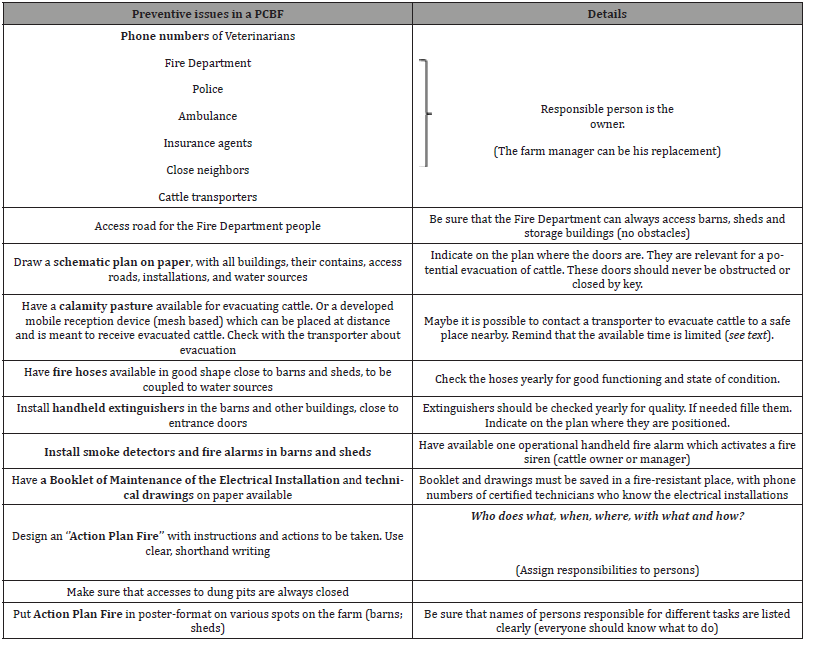
Table 4:Major example of measures and actions in case of a cattle barn fire (the curative part of a PCBF).
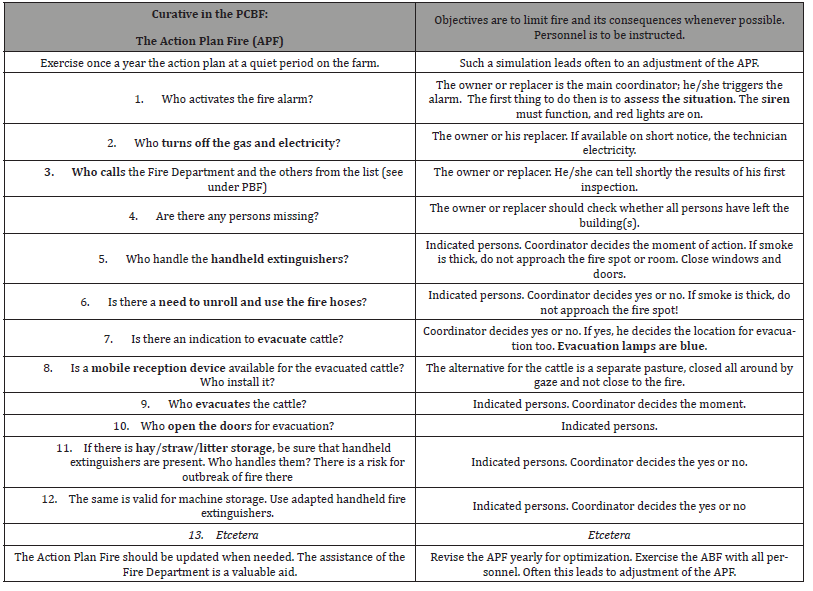
The initial inspection of the situation in case of fire is crucial. The owner or his manager uses a checklist for this purpose. This checklist includes the items such as those listed in Table 5, which are not exhaustive. This list is given to the fire chief upon arrival.
Table 5:A rough overview of topics on the checklist for first inspection of the fire situation in the barn or buildings [4]. The dotted lines indicate where figures or features are required.
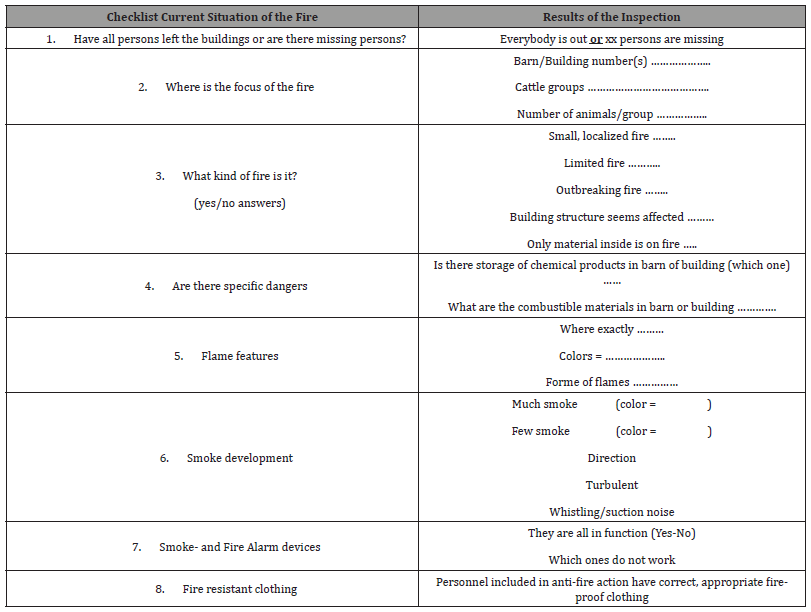
The fire resistance of a building (barn) according to the Dutch construction standard is at least 90 minutes [5].
This gives an indication of the time frame during which one must carry out fire-resisting actions by oneself.
To carry out an evacuation of people near a fire in a building (barn or house), one has less than 15 min. So, this evacuation is a necessary priority [6].
As for Fire-proof clothing, one should think of clothing made from natural fibers (linen, flannel, cotton) and professional firefighter clothing. One can also think about creating some specific fire blankets cupboards.
Discussion and Conclusion
A veterinarian conducting a farm advisory program on a dairy farm with cattle seems to be a prime candidate to support the animal owner in the preliminary design of a PCBF and an APF. After all, the veterinarian can provide valuable, additional information for the protocols from a neutral perspective.
Obviously, it is wise to do a further elaboration of the PCBF (preventive and curative), specific to the farm with the assistance of the Fire Department. The preventive part is usually a matter for the cattle owner/manager because it involves strategic choices. The curative part is a matter for the entire farm team.
The PCBF and APF, once developed, should be practiced, and questioned every year and adjusted as deemed necessary. The input of staff members is important because in the event of a fire, one must work as a “cohesive team” and responsibly.
It should not be forgotten that practicing the curative plan (APF) in the event of a simulated fire alarm usually leads to adjustments to the APF in the post-fire debriefings. Practicing is thus an important part of PCBF and APF in practice.
Another matter of great importance concerns the safety of people. In case of a heavy fire (a lot of fire and flames, a lot of smoke) it is wiser to wait for the Fire Department and certainly not to enter a burning building with a fire extinguisher or fire hose. Fireextinguishing equipment other than handheld extinguishers and fire hoses has not been addressed here, because that extinguishing equipment is so professional that it often requires several people to be deployed at once to man one piece of equipment (e.g., the mist ball, the Fog nail, large fans, pressurized air foam) and that this equipment is far too expensive for a single cattle farm and its operation requires specific training.
Aside from the flames, there is also the smoke that can burn and contains various toxic chemicals and fine particles, depending on what is being burned in the fire. Initial signs of difficult breathing indicate smoke poisoning in both humans and cattle [3].
This article was written because the Protocol Cattle Barn Fires (PCBF) fits into modern animal husbandry, where welfare plays a major role.
In addition to a Biosecurity Plan for preventing the introduction and/or spread of infectious agents, as is increasingly applied on dairy farms [7], a PCBF and an Action Plan Fire (APF) are an excellent fit for high quality farm management. So, the step to follow up with PCBF and APF is a logical one. This further emphasizes the role of the veterinarian-farm advisor in animal health, farm management and risk factors from the animals’ environment.
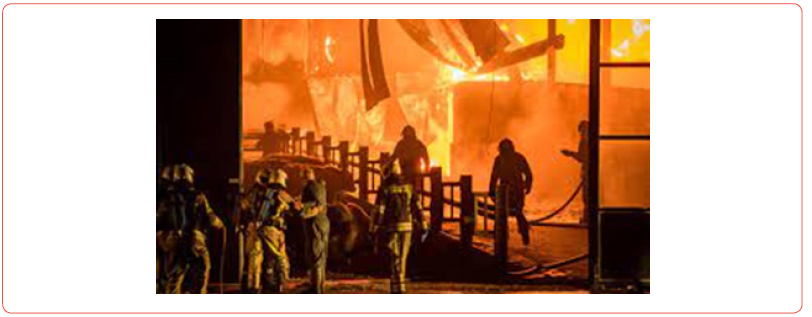
Acknowledgment
None.
Conflict of Interest
No conflict of interest.
References
- Zandvliet M (2020) Top 10 Causes of fires (in Dutch). Via kluisstore.nl and www.bgmagazine.nl.
- Petra Blogger.com. Working on Quality. blogspot.com ‘Protocol Fire’ (in Dutch).
- Noordhuizen J (2023) Respiratory Health in Horses and Effects of Forest Fires, with special attention to Man (A Review). Journal of Aquaculture and Livestock Production 4(1).
- Hagen R, Hendriks A, Molenaar J (2014) Kwadrantenmodel voor gebouwbrandbestrijding. Brandweer Nederland & Instituut Fysieke Veiligheid/ Brandweer academie, Arnhem, The Netherlands (in Dutch). 48 pp.
- Bouwbesluit Online 2012.
- Nieman Academy.
- Noordhuizen J (2012) Dairy Herd Health & Management – Section Biosecurity, pages 43-77. Context Products Ltd, Packington, UK.
-
Noordhuizen Jos P*. Developing a Protocol “Cattle Barn Fire”. Arch Animal Husb & Dairy Sci. 2(4): 2022. AAHDS. MS.ID.000545.
-
Cattle barn fire, Farms, Protocol farm fire, Cattle barns
-

This work is licensed under a Creative Commons Attribution-NonCommercial 4.0 International License.






